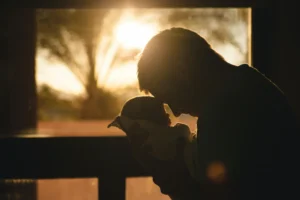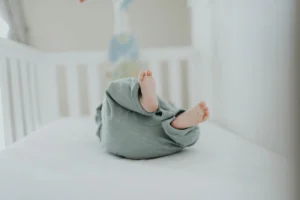Your toddler’s potty training will absolutely affect their sleep. If you go into this transition period informed, you can lessin the sleepless nights.
The Potty Training Timeline
When you start potty training, it is a good idea to start by only focusing on daytime. Use a pull up at night time so that your child isn’t losing sleep during this initial transition period. Once your little one is day time potty trained, or by the age of 3.5, you should start to introduce night time potty training.
If your child isn’t sleep trained yet, work on that before working on night time potty training. One transition at a time is less overwhelming for toddlers and will have better success. Parents also tend to get less frustrated when they are experiencing more parenting “wins.”
Avoiding Accidents
Encourage your toddler to use the potty as much as possible during the day. Also, minimize evening liquid intake. When following your bedtime routine, be sure to incorporate using the potty so that their bladder is empty before bed.
Following these recommendations will greatly reduce the odds of accidents. Even if you follow these, there is still the possibility of an accident occurring. In that case, show your little one and yourself grace and patience. Staying calm will help your child find their way to success faster.
Being Prepared
Accidents are inevitable. Before beginning potty training, we highly recommend purchasing a waterproof mattress cover, this will make accident clean up much easier. When your toddler starts going to bed without a pull up on, be prepared to handle accidents in the most efficient way possible. Have extra bedding, underwear, and pajamas easily accessible. You will most likely be woken up by a nervous, sad or upset toddler letting you know what happened. Start by reassuring them that everything is OK. Keep the lights dim so that your little one isn’t too stimulated and get to work on the following steps:
- Get your little one cleaned up
- Get them in their fresh undies and pjs
- Change their bedding
- Have them attempt to use the toilet before getting back into bed
- Tuck them back into bed and offer reassurance
Following these to the point steps will decrease the amount of time everyone is awake. This will help everyone get back to sleep sooner rather than later.
There will be ups and downs during any transition. You should remember that consistency is best for your little one to adapt to the change. With this particular transition, patience will be so important. Your little one will get there and you will get your rest-filled nights back. If you are not seeing the progress you would like, you are welcome to reach out for advice!





